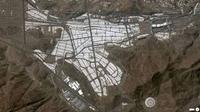-
Could the Sydney siege have been predicted and prevented?
It’s the question everyone is asking — could the Sydney siege have been predicted and therefore prevented based on the past behavior of gunman Man Haron Monis. Monis’s troubled history was well known to media and the police, but can we predict if and when such a person is likely to commit any further crimes? Further, we need to be very careful about stereotyping the mentally ill as potentially “dangerous.” It is simply not the case that all people with serious mental illnesses are prone to violence. There are very specific factors that govern the complex relationship between mental illness and violence. We need to understand and prevent people from experiencing them.
-
-
Helping coastal communities to visualize sea-level rise
As part of the Federal Emergency Management Agency’s (FEMA) initiative to encourage communities to become more aware of the effects of climate change, the agency has awarded Marin County, California a $150,000 grant to engage residents in climate change issues by allowing them to visualize the effects of sea level rise. The grant will pay for two sophisticated viewfinders programed to envision how the landscape will appear in projected sea level rise scenarios, as well as how the landscape appeared in the past.
-
-
It will take 11 trillion gallons to replenish California drought losses: NASA
Since 2011, the Sacramento and San Joaquin river basins decreased in volume by four trillion gallons of water each year (fifteen cubic kilometers). This is more water than California’s thirty-eight million residents use each year for domestic and municipal purposes. About two-thirds of the loss is due to depletion of groundwater beneath California’s Central Valley. It will take about eleven trillion gallons of water (forty-two cubic kilometers) — around 1.5 times the maximum volume of the largest U.S. reservoir — to recover from California’s continuing drought, according to a new analysis of NASA satellite data.
-
-
Radicalization and the lone wolf: what we do and don’t know
Even with the growing body of empirical research contributing to understanding radicalization, cases such as that of Man Haron Monis raise questions about whether individual actors, known as “lone wolves,” are terrorists, violent extremists, radicals, or simply lone gun men. Contrary to popular belief, ideology and religion play a less important role in radicalization. Current research indicates that the emotional appeal to personal identity and group solidarity are far more significant factors in radicalization. What recent lone-wolf cases — Man Haron Monis in Sydney, Canadian Michael Zehaf-Bibeau, Anders Breivik in Norway, and Mohammed Merah in France — tell us is that, unlike the strategic model of terrorism as a rational choice to carry out acts of violence in the name of a cause, these modern-day lone-wolf terrorists may be more like lone gunmen than terrorists.
-
-
Improved protective suit for Ebola caregivers
An advanced protective suit for health care workers who treat Ebola patients, devised by a Johns Hopkins University team, is one of the first five awardees in a federal funding contest aimed at quickly devising new tools to combat the deadly disease. The JHU prototype is designed to do a better job than current garments in keeping health care workers from coming in contact with Ebola patients’ contagious body fluids, both during treatment and while removing a soiled suit. In addition, it is expected to keep the wearer cooler — an important benefit in hot, humid regions such as West Africa.
-
-
Better forecasts for rain-on-snow flooding
Many of the worst West Coast winter floods pack a double punch. Heavy rains and melting snow wash down the mountains together to breach river banks, wash out roads and flood buildings. These events are unpredictable and difficult to forecast. Yet they will become more common as the planet warms and more winter precipitation falls as rain rather than snow. Mountain hydrology experts are using the physics behind these events to better predict the risks.
-
-
Helping first-response robots operate for longer periods
Through a project supported by the Defense Advanced Research Projects Agency (DARPA), Sandia Lab is developing technology which will dramatically improve the endurance of legged robots, helping them operate for long periods while performing the types of locomotion most relevant to disaster response scenarios. One of Sandia’s new robots which showcases this technology will be demonstrated at an exposition to be held in conjunction with the DARPA Robotics Challenge Finals next June.
-
-
Colleges, labs develop STEM core curriculum
The success of Lawrence Livermore National Laboratory’s Engineering Technology Program to educate veterans for technical careers has inspired a statewide push to create an educational core curriculum to prepare junior college students for technical jobs at California’s national labs. The core curriculum being designed by a consortium of community colleges, national labs, and nonprofit educational institutes emphasizes a heavy focus on science, technology, engineering, and math (STEM) courses to prepare women, minorities, veterans, and other underserved populations for high-paying jobs as technologists.
-
-
Public support for torture declines as people learn the explicit details of torture techniques
Does the American public condone torture when the goal is to prevent terrorist attacks? News headlines reporting the results of a Pew Research Center poll released on 9 December indicate more than half of Americans do. That finding, however, is not necessarily valid, says Tufts University’s Richard Eichenberg, who argues that the poll is flawed because it is based on a faulty premise. A more accurate picture of the nation’s attitude can be found in responses to polls conducted by Pew, Gallup, and other news organizations and analyzed in a 2010 report. These surveys explained in graphic detail what interrogation techniques were being judged. So while response to more general questions on the use of torture may continue to produce mixed reactions, Eichenberg says public support for torture will decline as more people become aware of the explicit details of torture techniques contained in the Senate report.
-
-
Mecca faces severe air pollution during annual pilgrimage

Dangerously high levels of air pollutants are being released in Mecca during the hajj, the annual holy pilgrimage in which millions of Muslims on foot and in vehicles converge on the Saudi Arabian city, according to findings of a new study. “Hajj is like nothing else on the planet. You have 3 to 4 million people — a whole good-sized city — coming into an already existing city,” said one researcher. “The problem is that this intensifies the pollution that already exists. We measured among the highest concentrations our group has ever measured in urban areas — and we’ve studied seventy-five cities around the world in the past two decades.”
-
-
Ethnic diversity among traders makes markets less likely to suffer bubbles: Study
Stock market bubbles have led to economic catastrophes from the Great Depression through the dot-com boom of the 1990s and up to the recent housing financial crisis. Although these episodes cause widespread financial havoc, the reasons behind economic bubbles remain unclear. A new study proposes a cause: Bubbles happen when people mindlessly trust the behavior of others, particularly when surrounded by ethnic peers. The researchers found that markets of ethnically diverse traders are much less likely to suffer bubbles. These findings could have a lasting impact on economics — and ethnic diversity.
-
-
New chemical sponge would lessen the carbon footprint of oil industry
U.K. scientists have discovered a ground-breaking technique with the potential dramatically to reduce the amount of energy used in the refinement of crude oil. The existing industrial process uses huge amounts of energy to separate and purify these gases, so the new technique has the potential to revolutionize the oil industry by significantly reducing carbon emissions and making the process more environmentally friendly.
-
-
Helicopter steering innovation could herald new era for aerial transport

For decades, flying cars have featured in our visions of what futuristic cities might look like. Now EU-funded researchers with the MYCOPTER project have developed a steering system that makes helicopters as easy to control as cars. While having your own personal aerial vehicle (PAV) may still be some way off, the success of the project opens up the possibility that one day flying vehicles could indeed be an integral part of the urban transportation network.
-
-
A first: U.S. Navy shipboard laser operates in Persian Gulf

The U.S. Navy announced that a laser weapon system (LaWS) — a cutting-edge weapon that brings significant new capabilities to America’s Sailors and Marines — was for the first time successfully deployed and operated aboard a naval vessel in the Persian Gulf. The operational demonstrations, which took place from September to November aboard USS Ponce (AFSB[I] 15), were historic not only because they showed a laser weapon working aboard a deployed U.S. Navy ship, but also because LaWS operated seamlessly with existing ship defense systems. During the tests, LaWS hit targets mounted aboard a speeding oncoming small boat, shot a Scan Eagle unmanned aerial vehicle (UAV) out of the sky, and destroyed other moving targets at sea.
-
-
2012-14 California drought the worst in 1,200 years
New research shows that the California drought of 2012-14 has been the worst in 1,200 years. California is the world’s eighth largest economy and the source of a substantial amount of U.S. produce. Surface water supply shortages there have impacts well beyond the state’s borders. The research indicates that natural climate system variability is compounded by human-caused climate change and that “hot” droughts such as the current one are likely to occur again in the future.
-
More headlines
The long view
New Technology is Keeping the Skies Safe
DHS S&T Baggage, Cargo, and People Screening (BCP) Program develops state-of-the-art screening solutions to help secure airspace, communities, and borders
Factories First: Winning the Drone War Before It Starts
Wars are won by factories before they are won on the battlefield,Martin C. Feldmann writes, noting that the United States lacks the manufacturing depth for the coming drone age. Rectifying this situation “will take far more than procurement tweaks,” Feldmann writes. “It demands a national-level, wartime-scale industrial mobilization.”
How Artificial General Intelligence Could Affect the Rise and Fall of Nations
Visions for potential AGI futures: A new report from RAND aims to stimulate thinking among policymakers about possible impacts of the development of artificial general intelligence (AGI) on geopolitics and the world order.
Smaller Nuclear Reactors Spark Renewed Interest in a Once-Shunned Energy Source
In the past two years, half the states have taken action to promote nuclear power, from creating nuclear task forces to integrating nuclear into long-term energy plans.
Keeping the Lights on with Nuclear Waste: Radiochemistry Transforms Nuclear Waste into Strategic Materials
How UNLV radiochemistry is pioneering the future of energy in the Southwest by salvaging strategic materials from nuclear dumps –and making it safe.
Model Predicts Long-Term Effects of Nuclear Waste on Underground Disposal Systems
The simulations matched results from an underground lab experiment in Switzerland, suggesting modeling could be used to validate the safety of nuclear disposal sites.
